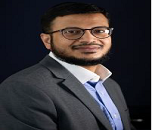Day 1 :
Keynote Forum
Syed Ghufran Hashmi
University of Oulu, Finland
Keynote: Perovskites based printable and scalable photovoltaic technology

Biography:
Syed Ghufran Hashmi has recently joined University of Oulu-Finland as Tenure Track Assistant Professor. Before joining Oulu University, he worked in the Department of Applied Physics at Aalto University-Finland for more than a decade in different positions. He moved to Finland in 2007 and completed his Masters in Micro and Nanotechnology from Helsinki University of Technology. After that, he joined New Energy Technologies Research Group at Department of Applied Physics at Aalto University-Finland and completed his doctoral degree in Advanced Energy Systems. His scientific ideas have received nearly 2 ME funding from prestigious funding organizations such as Academy of Finland and Business Finland. He is presently the author of nearly 30 scientific publications, which has received more than 700+ citations.
Abstract:
Keynote Forum
Mohsen Bayat
Khajeh Nasir Toosi University of Technology, Iran
Keynote: Solar-driven direct Z-scheme using hierarchical CdS/SiC heterostructure for enhanced photocatalytic water splitting
Time : 10.30-11.00

Biography:
Mohsen Bayat is a master's student in Analytical Chemistry at the Khajeh Nasir Toosi University of Technology (KNTU: The Oldest Technical University in Iran). His main research interest and also master's thesis is in the fields of Photoelectrochemistry, Photocatalyst, Semiconductors, and Nanotechnology. Therefore, his research focus is on integrating theory and experiment with the design and fabrication of photoelectrodes for use in Photocatalytic and (Photo)electrochemical Water Splitting
Abstract:
Due to the increasing human need for energy, science is moving towards finding a sustainable and clean alternative to meet the world's energy needs; and among these, Photoelectrochemical and Photocatalytic Water Splitting is the best eco-friendly option! To attain an acceptable performance from overall water splitting, a photocatalyst must have a suitable band structure with sufficient redox power, and also definitely must have a high separation efficiency for photogenerated charge carriers, and have a sufficient number of active sites. But there are few photocatalysts that have all of these basic properties; However, a suitable and easy solution to achieve the photocatalytic reaction of this is to use the direct Z-scheme structured from two semiconductor photocatalysts.
When CdS and SiC are in contact, the transfer of free CdS electrons to SiC begins immediately and continues until their Fermi levels are balanced. Therefore, in the interface of these two semiconductors, CdS will have a positive charge, and SiC will have a negative charge. Hence, an internal electric field is created and causes the band edge bending. After excitation by incoming light, both photocatalysts have the ability to create electron-hole pairs. The formation of this internal electric field forms a passage for the recombination of electrons photogenerated in the CdS conduction band and holes photogenerated in the SiC valance band, and a barrier to the transfer of photogenerated electrons from the CdS CB to the SiC CB, as well as the barrier to the transfer of photogenerated holes from SiC VB to CdS VB. Meanwhile, the electrons of the CdS CB and the holes of the SiC VB are conserved and spatially separated and can participate in specific photocatalytic reactions.The photocatalytic performance direct Z-scheme photocatalysts depend on their morphology. studies have shown that hierarchical structure photocatalysts have the best form; Large specific surface area, sufficient porous structure, more surface-active sites, and better mass transfer.
